Grand Prix motor racing
.jpg)
Grand Prix motor racing has its roots in organised automobile racing that began in France as far back as 1894. It quickly evolved from a simple road race from one town to the next, to endurance tests for car and driver. Innovation and the drive of competition soon saw speeds exceeding 100 miles per hour (160 km/h), but because the races were held on open roads there were frequent accidents with fatalities resulting to both drivers and spectators.
Grand Prix motor racing eventually evolved into formula racing, and Formula One can be seen as its direct descendant. Each event of the Formula One World Championships is still called a Grand Prix; Formula One is referred to as Grand Prix racing.
Origins of organized racing

Motor racing was started in France, as a direct result of the enthusiasm with which the French public embraced the motor car.[1] Manufacturers were enthusiastic due to the possibility of using motor racing as a shop window for their cars.[1] The first motoring contest took place on July 22, 1894 and was organised by a Paris newspaper, Le Petit Journal. The Paris–Rouen rally was 126 km (78 mi), from Porte Maillot in Paris, through the Bois de Boulogne, to Rouen. Count Jules-Albert de Dion was first into Rouen after 6 hours 48 minutes at an average speed of 19 km/h (12 mph). He finished 3 minutes 30 seconds ahead of Albert Lemaître (Peugeot), followed by Doriot (Peugeot, 16 minutes 30 seconds back), René Panhard (Panhard, 33 minutes 30 seconds back), and Émile Levassor (Panhard, 55 minutes 30 seconds back). The official winners were Peugeot and Panhard as cars were judged on their speed, handling and safety characteristics, and De Dion's steam car needed a stoker which the judges deemed to be outside of their objectives.[2][3]
In 1900, James Gordon Bennett, Jr., the owner of the New York Herald and the International Herald Tribune, established the Gordon Bennett Cup. He hoped the creation of an international event would drive automobile manufacturers to improve their cars.[4] Each country was allowed to enter up to three cars, which had to be fully built in the country that they represented and entered by that country's automotive governing body.[4] International racing colours were established in this event.[4] The 1903 event occurred in the aftermath of the fatalities at the Paris-Madrid road race, so the race, at Athy in Ireland, though on public roads, was run over a closed circuit: the first ever closed-circuit motor race.
In the United States, William Kissam Vanderbilt II launched the Vanderbilt Cup at Long Island, New York in 1904.
First Grands Prix
Circuit du Sud-Ouest
Some anglophone sources wrongly list a race called the Pau Grand Prix in 1901. This may stem from a mistranslation of the contemporary French sources such as the magazine La France Auto of March 1901.[5] The name of the 1901 event was the Circuit du Sud-Ouest and it was run in three classes around the streets of Pau. The Grand Prix du Palais d’Hiver was the name of the prizes awarded for the lesser classes ('Light cars' and 'Voiturettes'). The Grand Prix de Pau was the name of the prize awarded for the 'Heavy' (fastest) class. Thus Maurice Farman was awarded the 'Grand Prix de Pau' for his overall victory in the Circuit du Sud-Ouest driving a Panhard 24 hp. [Note 1][Note 2][Note 3]
In L’Histoire de l’Automobile/Paris 1907 Pierre Souvestre described the 1901 event as : “... dans le Circuit du Sud-Ouest, à l’occasion du meeting de Pau... ” (...in the Circuit du Sud-Ouest, at the meeting in Pau...)[6]
First Grand Prix and the Grandes Épreuves
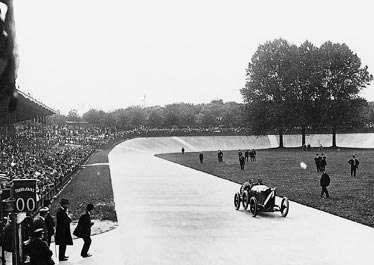
The only race at the time to regularly carry the name Grand Prix was organised by the Automobile Club de France (ACF), of which the first took place in 1906. The circuit used, which was based in Le Mans, was roughly triangular in shape, each lap covering 105 kilometres (65 mi). Six laps were to run each day, and each lap took approximately an hour using the relatively primitive cars of the day. The driving force behind the decision to race on a circuit - as opposed to racing on ordinary roads from town to town - was the Paris to Madrid road race of 1903. During this race a number of people, both drivers and pedestrians - including Marcel Renault - were killed and the race was stopped by the French authorities at Bordeaux. Further road based events were banned.
From the 32 entries representing 12 different automobile manufacturers, at the 1906 event, the Hungarian-born Ferenc Szisz (1873–1944) won the 1,260 km (780 mi) race in a Renault. This race was regarded as the first Grande Épreuve, which meant "great trial" and the term was used from then on to denote up to the eight most important events of the year.[7]
Races in this period were heavily nationalistic affairs, with a few countries setting up races of their own, but no formal championship tying them together. The rules varied from country to country and race to race, and typically centered on maximum (not minimum) weights in an effort to limit power by limiting engine size indirectly (10–15 L engines were quite common, usually with no more than four cylinders, and producing less than 50 hp). The cars all had mechanics on board as well as the driver, and no one was allowed to work on the cars during the race except for these two. A key factor to Renault winning this first Grand Prix was held to be the detachable wheel rims (developed by Michelin), which allowed tire changes to occur without having to lever the tire and tube off and back on the rim. Given the state of the roads, such repairs were frequent.
Political numbering and renaming
A further historic confusion arose in the early 1920s when the Automobile Club de France attempted to pull off a retrospective political trick by numbering and renaming the major races held in France before the 1906 French Grand Prix as being Grands Prix de l'Automobile Club de France, despite their running pre-dating the formation of the Club. Hence, the 1895 Paris–Bordeaux–Paris Trail was renamed I Grand Prix de l'Automobile Club de France; and the true first Grand Prix in 1906 race was renamed the IX Grand Prix de l'Automobile Club de France (9th). The ACF used this numbering in 1933, although some members of the Club dismissed it, "concerned the name of the Club was lent to the fiction simply out of a childish desire to establish their Grand Prix as the oldest race in the world."[8][9][Note 4]
Racecourse development
.jpg)
For the most part, races were run over a lengthy circuit of closed public roads, not purpose-built private tracks. This was true of the Le Mans circuit of the 1906 Grand Prix, as well as the Targa Florio (run on 93 miles (150 km) of Sicilian roads), the 75 miles (121 km) German Kaiserpreis circuit in the Taunus mountains, and the French circuit at Dieppe (a mere 48 miles (77 km)), used for the 1907 Grand Prix. The exceptions were the steeply banked egg-shaped near oval of Brooklands in England, completed in 1907, the Indianapolis Motor Speedway, first used in 1909 with the first Indianapolis 500-Mile Race in 1911, and the Autodromo Nazionale Monza, in Italy, opened in 1922.
In 1908, the United States of America became the first country outside France to host an automobile race using the name Grand Prix (or Grand Prize), run at Savannah. The first Grande Épreuve outside France was the 1921 Italian Grand Prix held at Brescia. This was quickly followed by Belgium and Spain (in 1924), and later spread to other countries including Britain (1926). Strictly speaking, this still wasn't a formal championship, but a loose collection of races run to various rules. (A "formula" of rules had appeared just before World War I, finally based on engine size as well as weight, but it was not universally adopted.)
In 1904, many national motor clubs banded together to form the Association Internationale des Automobile Clubs Reconnus (AIACR). In 1922 the Commission Sportive Internationale (CSI) was empowered on behalf of AIACR to regulate Grand Prix racing and other forms of international racing. Since the inception of Grand Prix racing, competitions had been run in accordance with a strict formula based on engine size and vehicle weight. These regulations were virtually abandoned in 1928 with an era known as Formula Libre when race organisers decided to run their events with almost no limitations. From 1927 to 1934, the number of races considered to have Grand Prix status exploded, jumping from five events in 1927, to nine events in 1929, to eighteen in 1934 (the peak year before World War II).
During this period a lot of changes of rules occurred. There was a mass start for the first time at the 1922 French Grand Prix in Strasbourg. The 1925 season was the first season during which no riding mechanic was required in a car, as this rule was repealed in Europe after the death of Tom Barrett in previous year. At the 1926 Solituderennen a well thought-out system, with flags and boards, giving drivers tactical information, was used for the first time by Alfred Neubauer, the racing manager of the Mercedes-Benz team.
The Pre-WW II years
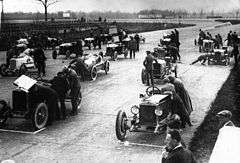
The 1933 Monaco Grand Prix was the first time in the history of the sport that the grid was determined by timed qualifying rather than the luck of a draw.
All the competing vehicles were painted in the international auto racing colors:
- blue (Bleu de France) for France,
- green (British racing green) for Britain,
- red (Rosso corsa) for Italy,
- white for Germany,
- Note: beginning in 1934, the Germans stopped painting their cars, allegedly after the paint had been left off a Mercedes-Benz W25 in an effort to reduce weight. The unpainted metal soon had the German vehicles dubbed by the media as the "Silver Arrows".
- yellow for Belgium.
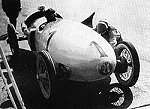
French cars continued to dominate (led by Bugatti, but also including Delage and Delahaye) until the late 1920s, when the Italians (Alfa Romeo and Maserati) began to beat the French cars regularly. At the time, the Germans engineered unique race vehicles as seen in the photo here with the Benz aerodynamic "teardrop" body introduced at the 1923 European Grand Prix at Monza by Karl Benz.
In the 1930s, however, nationalism entered a new phase when the Nazis encouraged Mercedes and Auto Union to further the glory of the Reich. (The government did provide some money to the two manufacturers, but the extent of the aid into their hands was exaggerated in the media; government subsidies amounted to perhaps 10% or less of the costs of running the two racing teams.)[10] The two German marques utterly dominated the period from 1935 to 1939, winning all but three of the official Championship Grands Prix races run in those years. The cars by this time were single-seaters (the riding mechanic vanished in the early 1920s), with 8 to 16 cylinder supercharged engines producing upwards of 600 hp (450 kW) on alcohol fuels.
As early as October 1923, the idea of an automobile championship was discussed at the annual autumn conference of the AIACR (Association Internationale des Automobile Clubs Reconnus) in Paris. However, discussion centered on the increased interest in racing by manufacturers and holding the first European Grand Prix at Monza in 1923. The first World Championship took place in 1925, but it was for manufacturers only, consisting of four races of at least 800 km (497 mi) in length. The races that formed the first Constructors Championship were the Indianapolis 500, the European Grand Prix, and the French and Italian Grands Prix. A European Championship, consisting of the major Grand Prix in a number of countries (named Grandes Epreuves) was instituted for drivers in 1935, and was competed every year until the outbreak of World War II in 1939.
The post-war years and Formula One
Related topics : Formula One, History of Formula One
In 1946, following World War II, only four races of Grand Prix calibre were held. Rules for a Grand Prix World Championship had been laid out before World War II, but it took several years afterward until 1947 when the old AIACR reorganised itself as the Fédération Internationale de l'Automobile or "FIA" for short. Headquartered in Paris, at the end of the 1949 season it announced that for 1950 they would be linking several national Formula One Grands Prix to create a World Championship for drivers, although due to economic difficulties the years 1952 and 1953 were actually competed in Formula Two cars. A points system was established and a total of seven races were granted championship status including the Indianapolis 500. The first World Championship race was held on 13 May at Silverstone in the United Kingdom.
The Italians once again did well in these early World Championship races, both manufacturers and drivers. The first World Champion was Giuseppe Farina, driving an Alfa Romeo. Ferrari appeared at the second World Championship race, in Monaco, and has the distinction of being the only manufacturer to compete throughout the entire history of the World Championship, still competing in 2016.
Grandes Épreuves by season
Notes:
- For the Grand Prix races from 1950 onwards, see List of Formula One Grands Prix.
- Italics denote that the race was also known as the European Grand Prix.
1906–1914
| Race | 1906 | 1907 | 1908 | 1912 | 1913 | 1914 |
|---|---|---|---|---|---|---|
| 1 | |
|
|
|
|
|
1921–1929
1930–1939
For wartime events, see 1940-1945 Grand Prix season.
1946–1949
| Race | 1946 | 1947 | 1948 | 1949 |
|---|---|---|---|---|
| 1 | |
|
|
|
| 2 | |
|
|
|
| 3 | |
|
|
|
| 4 | |
|
| |
| 5 | |
|
Other events
See also:
- List of major automobile races in France
- List of major automobile races in Germany
- List of major automobile races in Italy
Grand Prix drivers
Notable drivers of the Grand Prix motor racing era included a few women who competed equally with the men:
.svg.png) Antonio Ascari - Italy
Antonio Ascari - Italy Robert Benoist - France
Robert Benoist - France.svg.png) Clemente Biondetti - Italy
Clemente Biondetti - Italy Georges Boillot - France
Georges Boillot - France Manfred von Brauchitsch - Germany
Manfred von Brauchitsch - Germany Malcolm Campbell - Great Britain
Malcolm Campbell - Great Britain Rudolf Caracciola - Germany
Rudolf Caracciola - Germany.svg.png) /
/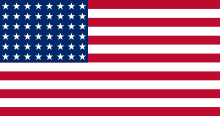 Luigi Chinetti - Italy; United States after the war
Luigi Chinetti - Italy; United States after the war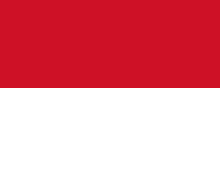 Louis Chiron - Monaco
Louis Chiron - Monaco Albert Divo - France
Albert Divo - France René Dreyfus - France
René Dreyfus - France Philippe Étancelin - France
Philippe Étancelin - France.svg.png) Luigi Fagioli - Italy
Luigi Fagioli - Italy.svg.png) Giuseppe Farina - Italy; he became the first Formula One champion
Giuseppe Farina - Italy; he became the first Formula One champion.svg.png) Enzo Ferrari - Italy
Enzo Ferrari - Italy Jules Goux - France
Jules Goux - France Elizabeth Junek - Czechoslovakia
Elizabeth Junek - Czechoslovakia Hermann Lang - Germany
Hermann Lang - Germany Christian Lautenschlager - Germany
Christian Lautenschlager - Germany.svg.png) Emilio Materassi - Italy
Emilio Materassi - Italy
.svg.png) Felice Nazzaro - Italy
Felice Nazzaro - Italy Guy Moll - Algeria
Guy Moll - Algeria Hellé Nice - France
Hellé Nice - France.svg.png) Tazio Nuvolari - Italy
Tazio Nuvolari - Italy Kay Petre - Great Britain
Kay Petre - Great Britain Charles Pozzi - France
Charles Pozzi - France Georges Philippe (Baron Philippe de Rothschild) - France
Georges Philippe (Baron Philippe de Rothschild) - France Bernd Rosemeyer - Germany
Bernd Rosemeyer - Germany Richard Seaman - Great Britain
Richard Seaman - Great Britain Henry Segrave - Great Britain
Henry Segrave - Great Britain Raymond Sommer - France
Raymond Sommer - France Whitney Willard Straight - Great Britain
Whitney Willard Straight - Great Britain Hans Stuck - Germany
Hans Stuck - Germany Ferenc Szisz - Hungary
Ferenc Szisz - Hungary.svg.png) Achille Varzi - Italy
Achille Varzi - Italy.svg.png) Emilio Villoresi - Italy
Emilio Villoresi - Italy.svg.png) Luigi Villoresi - Italy
Luigi Villoresi - Italy William Grover-Williams - Great Britain
William Grover-Williams - Great Britain Jean-Pierre Wimille - France
Jean-Pierre Wimille - France Juan Zanelli - Chile
Juan Zanelli - Chile
Championships
From 1925 onwards, the AIACR and later the FIA organised World and European Championships for Grand Prix manufacturers, drivers and constructors:
- World Manufacturers' Championship (1925–1927)
- European Drivers' Championship (1931–1932, 1935–1939)
- World Drivers' Championship (1950–1980)
- International Cup for Constructors (1958–1980)
- Formula One World Drivers' Championship (1981–present)
- Formula One World Constructors' Championship (1981–present)
Notes
- ↑ Racing within the city of Pau dates from 1900 when the first edition of the Circuit du Sud-Ouest was run in the city.
- The first Circuit du Sud-Ouest on 25 February 1900 was won by René de Knyff in a Panhard 16 hp. (Grand Prix Winners 1895–1949 by Hans Etzrodt Part 1 1895–1916)
- ↑ La France Automobile, March 1901 reports the results for the 'Semaine de Pau'. There were two discrete events, the 140 km Course des touristes from Pau-Peyrehorade-Pau and the second edition of the Circuit du Sud-Ouest on 17 February 1901 around a course on the city outskirts.
The Course des touristes comprised six prizes for the different classes of entrants. The Prix de la Presse was won by Barbereau (De Dietrich); the Prix du Commerce Palois was awarded to Henri Farman (Darracq); the Prix des Cercles was awarded to Rudeaux (Darracq); the Prix de l’Automobile Club Béarnais was won by 'Bergeon' (De Dietrich); the Prix de l’Automobile Club de France was awarded to Demeester (Gladiator) and Edmond (Darracq); the Prix de Palmarium was awarded to Cormier (De Dion).(Autosport, The Nostalgia Forum, Robert Dick quoting (translating) from La France Automobile, March 1901
The Circuit du Sud-Ouest comprised four prizes for the different classes of entrants.
- The Grand Prix de Pau was awarded to Maurice Farman (Panhard 24 hp).
- The Grand Prix du Palais d’Hiver (400 à 650 kg 'Light car' class) was awarded to Henri Farman (Darracq).
- The second Grand Prix du Palais d’Hiver for the under 400 kg Voiturettesclass was awarded to Louis Renault (Renault).
- The Prix du Béarn was awarded to Osmont in a 'De Dion' tricycle.
- ↑ By the turn of the century the term Grand Prix had become common parlance in France, having been used since the Grand Prix de Paris horse race in 1886 (e.g. the Grand Prix de Paris for Cyclists in 1895) (New York Times, July 18, 1895, Grand Prix de Paris for Cyclists). Thus in the anglophone world the main winner's prize (Grand Prix de Pau) subsequently became synonymous with the event.(Leif Snellman (2002-05-27). "The first Grand Prix". 8W. FORIX. Retrieved 2011-01-28.)
- ↑ The falsely renamed and numbered Grand Prix de l'Automobile Club de France were:
- 1st Grand Prix de l'Automobile Club de France - 1895 Paris–Bordeaux–Paris;[11]
- 2nd Grand Prix de l'Automobile Club de France - 1896 Paris–Marseille–Paris;[12]
- 3rd Grand Prix de l'Automobile Club de France - 1898 Paris–Amsterdam–Paris Trail;[13]
- 4th Grand Prix de l'Automobile Club de France - 1899 Tour de France Trail. 16–24 July;[14]
- 5th Grand Prix de l'Automobile Club de France - 1900 Paris-Toulouse-Paris Trail;[15]
- 6th Grand Prix de l'Automobile Club de France - 1901 Paris-Berlin Trail;[16]
- 7th Grand Prix de l'Automobile Club de France - 1902 Paris-Vienna Trail;[17]
- 8th Grand Prix de l'Automobile Club de France - 1903 Paris-Madrid Trail;[18]
- 9th Grand Prix de l'Automobile Club de France - 1906 1st Grand Prix de l'Automobile Club de France. (Le Mans);[19]
- 10th Grand Prix de l'Automobile Club de France - 1907 Grand Prix de l'Automobile Club de France. (Dieppe);[20]
- 11th Grand Prix de l'Automobile Club de France - 1908 Grand Prix de l'Automobile Club de France. (Dieppe);[21]
See also
References
- 1 2 Rendall, Ivan (1995). The Chequered Flag. Weidenfeld and Nicolson. p. 10. ISBN 0-297-83550-5.
- ↑ "Forix, Autosport, 8W - Welcome to Who? What? Where? When? Why? on the World Wide Web. ''The cradle of motorsport'' by Rémi Paolozzi, May 28, 2003". Forix.autosport.com. Retrieved 2011-09-24.
- ↑ Rendall, Ivan (1995). The Chequered Flag. Weidenfeld and Nicolson. p. 12. ISBN 0-297-83550-5.
- 1 2 3 Rendall, Ivan (1995). The Chequered Flag. Weidenfeld and Nicolson. p. 26. ISBN 0-297-83550-5.
- ↑ Autosport, The Nostalgia Forum, Robert Dick quoting (translating) from La France Automobile, March 1901
- ↑ Autosport, The Nostalgia Forum, Robert Dick quoting (translating) from 'L’Histoire de l’Automobile by Pierre Souvestre, published in Paris 1907
- ↑ Etzrodt, Hans. "Grand Prix Winners 1895-1949". The Golden Age. Retrieved 2007-04-03.
- ↑ Hodges (1967), pp. 2–3
- ↑ 1895 Grand Prix and Paris Races. Retrieved on 12 September 2009.
- ↑ Nixon, Chris (1986). Racing the Silver Arrows. Osprey Publishing Limited. p. 155. ISBN 0-85184-055-8.
- ↑ TeamDan, Early results database - 1895
- ↑ TeamDan, Early results database - 1896
- ↑ TeamDan, Early results database - 1898
- ↑ TeamDan, Early results database - 1899
- ↑ TeamDan, Early results database - 1900
- ↑ TeamDan, Early results database - 1901
- ↑ TeamDan, Early results database - 1902
- ↑ TeamDan, Early results database - 1903
- ↑ TeamDan, Early results database - 1906
- ↑ TeamDan, Early results database - 1907
- ↑ TeamDan, Early results database - 1908
External links
- Grandprix-Live.com - Covers all the major Grand Prix motorsport championships, including Formula One, MotoGP, NASCAR, IRL, WSBK, WRC Rally and many more.
- Grand Prix History - The Story of the Grand Prix